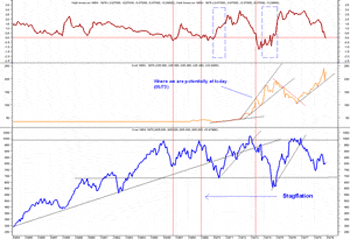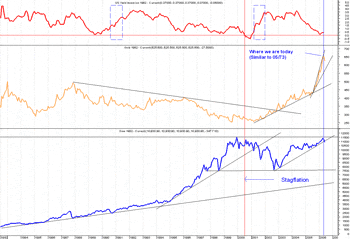1970-1982: A Possible Roadmap
Part 1
Troy Schwensen
Jun 9, 2006
Recently I conducted some economic research on the last bull
market we experienced in precious metals from 1970-1982. Given
the economic similarities we are faced with today, I did this
in an attempt to get a better understanding of where we are presently
placed and what we could potentially expect going forward.
The three areas I investigated included the following:
The Dow Jones Index: With a look at how it behaved in the
lead up to the 1970's and during the extended period of stagflation
that was experienced right up until 1982.
The Gold Price: I looked at how it moved and reacted to
various market conditions experienced during this period.
Yield Differential: I calculated this by taking the Yield
difference between US 10 year Treasury bonds and US 3 month Treasury
bills. There have been some excellent articles written that clearly
demonstrate the reliability of Yield Inversion in forecasting
a recession within a 6-12 month period. The basic theory is that
when the shorter term rate exceeds the longer term rate (Yield
Inversion) this infers the Federal Reserve's interest rate policy
is too tight in relation to inflation expectations (Indicated
by the 10 Year Bond rate). This consequently leads to a recession.
Part 1: 1970 - 1978
Today I want to share
with you the first part of my findings, which will be a brief
look at the years leading up to the 1970's with a closer look
at the first 8 years of the precious metals bull market that
took us up to the end of 1978. I will then compare this to the
present bull market and demonstrate what I believe are some useful
similarities. The first chart below is a look at the three areas
mentioned above in relation to the period of 1954 - 1978 (Monthly
Data).
[click on image to
enlarge]

A quick look at this chart
shows how the Dow Jones Index surged strongly right up to the
end of 1968 before it started to hit problems. The top section
of the chart demonstrates the Yield Differential. When this line
dips below zero (Indicated by the red horizontal line) we experience
Yield Inversion. As you can see, two out of the three times this
occurred (Indicated by the Red vertical lines) in the period
under examination, a recession occurred within the following
6-12 months (Indicated by the Blue Rectangles). The Dow Jones
index during and leading up to these recessions sold off (as
you would expect). Now the thing that caught my attention when
looking at the Dow Jones Index during this period was the similar
pattern it had formed to the chart we presently look at today.
After the extended rally through the 50's and 60's the Dow leveled
off and started to consolidate in a range between its peak and
about 30-40% below. The next chart is the same look at the Dow
Jones Index but from 1982 to the Present (Monthly Data).

The first thing you will notice
is the Dow Jones Index rallies strongly into 2000 where like
1969 it also hits a brick wall. A quick look at the Yield Differential
shows that this inverted during the middle of 2000 (Red Vertical
line) before the US economy went into a recession in 2001 (Indicated
by the blue rectangle). When you compare these two periods of
time, I believe they look very similar. The Dow Jones Index lost
30%+ during the recessionary period of 1969 to 1970 as it did
between 2000 and 2002. The resulting Federal Reserve Policy during
this period was a predictable aggressive easing of short term
rates. Here lies the beginning of the problem as you start to
enter a Stagflation environment. You have a period in time where
economic growth stagnates but an inflationary problem is born
due to the extended period of low interest rates and easy money.
Therefore interest rates have to rise periodically to deal with
the resulting inflation problem. Each time the short term rates
are raised this puts pressure on the debt ridden economy and
another recession occurs. As you can see in the first chart,
two recessions were experienced in the first 8 years between
1970 and 1978. I can tell you two more occurred in the short
space of time between 1979 and 1982 (We will look at this period
in a future article down the track).
Your response at this point may be to simply say: "that's
fine but that was then and this is now!" Well you might
have a point but when you look at the yield differential we are
presently faced with (Indicated by the blue vertical line) and
the way the Dow Jones Index is currently behaving, you like me
might get a rather strong sense of Déjà vu. The
Dow Jones pretty much reached its highs of 1999/2000 recently
but did not stay there for very long. Federal Reserve Chairman
Ben Bernanke in a recent statement hinted that short term rates
would probably rise again later this month due to inflation fears.
This next rate rise may be enough to invert the yield curve again
which would spell out a pretty ominous warning sign to financial
markets.
What does all this mean for Gold?
It is my belief that
we are at a very similar stage to June 1973 (As indicated on
the chart). The Dow Jones Index is potentially topping out after
recovering from the stock market falls associated with the previous
recession in 2001. The Gold price is in the process of taking
a well earned breather much like the 22% fall that was experienced
during the period of April-September 1973. In my opinion this
is a healthy consolidation in preparation for a much larger rally
which could come with the easing of interest rate rises at some
point later this year. The dollar is presently struggling in
the midst of several interest rate hikes. The big question is
what will happen when the interest rates are put on hold or even
worse loosened to accommodate a falling stock market and a slowing
economy? One potential answer may be found in what happened post
September 1973.
During 1973, short term rates increased right up until the end
of August when they temporarily peaked at 8.67%. They had been
steadily increasing since February 1972 (When they were just
3.2%). Does this sound familiar? In response to a slowing economy
and a looming recession they then spent the next 12 months to
August 1974 in a tight range between 8.67% and 7.12%. During
this time Gold rallied strongly from US$105 an ounce to US$152.50,
an increase of 45% (It got as high as US$172.25). It remained
strong until the stock market consolidated again towards the
second half of 1974 after a lengthy fall. From August 1974 to
December 1976 interest rates eased from 8.96% back down to 4.35%,
during which time the stock market embarked on another post recession
rally (Similar to the one following the first recession in 1970).
Gold's rally continued until December 1974 when it peaked at
US$193 before embarking on a severe correction that took it as
low as US$104.38 during August 1976, a fall of close to 46% or
all of its preceding gains. My guess is with short term rates
being reduced to ease the recessionary conditions, the inflation
problem was played down by the Fed and the investment public
flocked back into the stock market at the expense of Gold. History
later proved that this easing of interest rates only exacerbated
the inflationary pressures to the point where they could no longer
be swept under the carpet. The Gold price towards the end of
1976 commenced what to this day has been the most spectacular
and longest rally in Gold market history. A record that I strongly
believe will be broken in the years to come.
Concluding Comments
I don't believe what
happened in the seventies and early eighties will be all that
dissimilar to how things may pan out in the present bull market
in precious metals. When I look at the challenges the Federal
Reserve is faced with today in juggling inflation with a slowing
economy, things look more or less the same. What ever happens,
you can see that things are not likely to be plain sailing. It
is true that trying to compare two times in economic history
and claim that history will repeat itself is fraught with danger.
However, I don't think it hurts to have a quick look back and
see the challenges one could potentially face given similar market
conditions. It was not all one way traffic for the Gold price,
nor was it all doom and gloom for stock markets either. In order
to devise an effective strategy to invest and trade in these
times I found the above exercise to be extremely useful. It is
fair to say that the Gold Bull market to this point has been
a fairly structured and predictable affair. As this bull market
matures, I think things are going to become a lot less predictable
and obviously a lot more volatile. Those fortunate enough to
have been around during the 70's and early 80's have already
had a useful insight as to how things might unfold. For the rest
of us, the best we can do is research this period and at least
get a sense of what to expect.
For anyone interested, I write a free monthly newsletter
in which I commentate on the precious metals markets and manage
two model portfolios, one being Australian, the other Canadian.
For anyone interested simply drop me an email at the address
below.
Troy Schwensen CPA
The
Global Speculator
Australia
Email: Troy.Schwensen@bigpond.com
Troy Schwensen
is a full time investor/Trader who spent 8 years in the Accounting
and Finance industry which included roles with blue chip Australian
companies such as Goodman Fielder and Fosters where he spent three
years as a Senior Business Analyst. He made a decision to leave
this industry in 2002 after discovering a long term opportunity
to invest and trade in the precious metals market where he has
since used his analytical skills to build a sound working knowledge
of the sector and its comprising companies.
Disclaimer: This publication has been prepared from a wide
variety of sources which the writer to the best of his knowledge
and belief considers accurate. The writer does not warrant the
accuracy of the information and forecasts contained in this publication.
This information is provided for educational purposes and nothing
written should be construed as a solicitation to buy and sell
securities.
Investors Please Note: In providing this advice the writer
does not take into account the investment objectives, financial
situation and particular needs of any particular person; and before
making an investment decision on the basis of the advice, the
investor needs to consider, with or without the assistance of
a securities adviser, whether the advice is appropriate in light
of the particular investment needs, objectives and financial circumstances
of the investor or prospective investor.
321gold Inc

|


